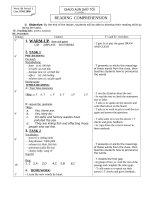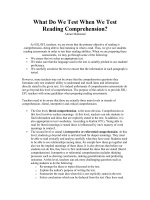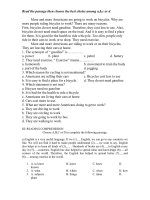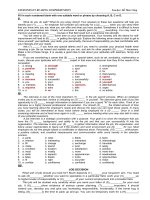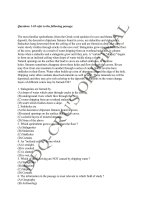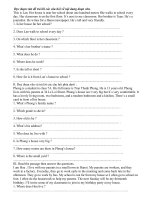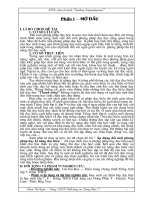reading comprehension (cont)
Bạn đang xem bản rút gọn của tài liệu. Xem và tải ngay bản đầy đủ của tài liệu tại đây (102.68 KB, 3 trang )
I. Complete the sentences. Each time use one of the verb form in the box with the correct
preposition (on / about / of / to / for).
E.g: 0. when I realised that I had taken the wrong umbrella, I immediately apologized for my
mistake.
belong care consist die apologize
wait depend dream listen
1. Tom is very selfish. He doesn't .................. other people.
2. "Does this bike .................. you?" - "No, it isn't mine."
3. "Are you playing tennis tomorrow?" - "I hope so, but it ................. the weather."
4. A soccer team ..................... 11 players.
5. If you smoke, there's a great chance that you will ................. lung cancer.
6. Last night, I ................. spending my vacation in the US.
7. He was ................ his children coming home from school.
8. I often .................. the radio while doing the housework.
II. Match the two half sentences in the two columns in a suitable way.
Column A Column B
1. If you need money to buy this book, ...
2. I will pick you up ...
3. If you want to gain weight, ...
4. If you work harder...
5. You should practise speaking English every
day ...
6. If you want to be healthier, ...
7. I will give this book to you ...
8. If you are too lazy, ...
a. if you want to improve it.
b. if you don't have your bike.
c. you should play sports every day.
d. you can ask your parents for some money.
e. you will pass the final exam.
f. your parents will punish you.
g. you have to eat a lot of meat.
h. if you like it.
III. Complete the sentences. Each time use one of the words in the box.
turn off exam miss advise vacation
questions press carelessly accident birthday
1. You should ............. the lights before going to bed.
2. We're going to have an English ................ this afternoon.
3. She will ............. a lot of lessons.
4. My parents ..................... me to learn harder for my final test.
5. I will attend an extra English course in my summer.
6. She is so intelligent that she can answer all my ...................
7. If you want to open the machine, you have to .................. the button.
8. She drives very ................. Last week, she had an ................
9. I wish I could go to your ..................... party next week.
IV. Read the following passage and answer the questions below.
Zamenhof invented a new language called Esperanto to improve understanding between
people of different countries. He showed Esperanto to his friends to find out what they thought about
it. Later in the same year he went to study at a university in Moscow. He wanted to improve
Esperanto. Zamenhof's friends then worked hard to spread the new language. They tried to persuade
schools throughout the world to teach it. However, only a few people today speak Esperanto because
more and more people use English as a foreign language.
1. Why did Zamenhof invented a new language?
2. What did he show Esperanto to his friends for?
3. Where did he go to study?
4. Who helped him to spread the new language?
5. Do many people today speak Esperanto?
V. Read the passage below and write T next to the true sentence; write F next to the false one.
A LANGUAGE EVERYONE KNOWS
There is one language we all speak, no matter what country we live in; the language of
numbers.
The language of numbers is called MATHEMATICS. You are learning it in school now. The
simplest kind is called ARITHMATIC. In high school and college you will learn other kind of
mathematics. To help all of us with mathematics, machines have been invented. They let us do
problems faster and with fewer mistakes. We know that the abacus or counting board was first of
these machines. It was invented many thousands of years ago, but it is still being used in China,
Japan, and other countries. Today, computers are used all over the world. These computers seem to
think. Of course, they really don’t. They do only what people tell them to do. But they do it much
better and faster than a person could. Inside, a computer may look very confusing to you. But the
people who run it know just what to do. They can make a computer store up facts and give them to
other people. They can make it solve hard problems and help us to live better. Like people all over the
world, these machines speak the same language: NUMBERS.
1. ......................... The simplest kind of mathematics is Arithmetic.
2. .......................... In high school and college you will learn arithmetic.
3. .......................... Machines do problems faster than men.
4. ......................... The counting board is no longer being used in the world.
5. .......................... Computers were invented a thousand years ago.
VI. Read the following passage and answer the questions below.
In Australia most children attend primary school from the age of five. Only two percent of
children of primary school age are educated at home. Some children who go to school also take up
extra activities such as learning to play a musical instrument or dancing, and they go to private classes
for these and for school subjects they find difficult or particularly interesting. Ninety percent of the
population go on to secondary school, but a much smaller percentage pass the final year of secondary
school examinations and complete a university degree. At the moment university students and
graduates make up less than a third of the total population. Australian universities are modern and
well equipped. Most teaching is by a combination of lectures, tutorials and practical classes. The
humanities course like History and Philosophy, usually involve a lot of extra reading in the library. To
become a primary or secondary school teacher, it is usually necessary to study at university for three
years or more.
1. When do children in Australia go to school?
2. How many percents of the population go on to secondary chool?
3. Do all of them pass the final year of secondary school exams?
4. How are Australian universities?
5. How many years is it usually to study at university to become secondary school teacher?
VII. Complete the following passage with a suitable word chosen from the box.
means pictures coverage entertainment make
events designed through bring out in addition to
Television is one of man's most important (1) of communication. It brings (2) and sounds
from around the world into millions of homes. A person with a television set can sit in his house and
watch the President (3) speech or visit a foreign country. He can see a war being fought and watch
statement try to (4) peace. (5) television, home viewers can see and learn about people, places and
things in faraway lands. Television even takes its viewers out of this world. It brings them (6) of
American's astronauts explore outer (7) all things, television brings its viewers a steady stream of
programs that are (8) to entertain. In fact, televison provides many more (9) programs that any other
kind. The programs include action-packed dramas, light comedies, sporting (10) and motion pictures.
VIII. Choose the suitable verbs with gerund form in the box to fill in the blanks.
reading borrowing visiting smoking
coming helping watching learning
1. At last I've decided to give up ................... cigarettes.
2. I like ....................... sport programs on TV.
3. In Vietnam, people love ...................... newspaper and magazines.
4. I spend most of time ........................ English.
5. Do you remember ........................ the old village church?
6. Would you mind ..................... me to move this chair?
7. I'm looking forward to ........................ back home.
8. I don’t like ........................... money from my friends.
IX. Complete the following dialogue.
An: What's the matter with you, Nam? You look tired.
Nam: (1)
An: You should take some aspirins.
Nam: (2)
An: So, you need to go and see the doctor at once.
Nam: (3)
An: Don't worry about that, the teacher will let you do the test again.
Nam: (4)
An: I will give your sick note to the teacher.
Nam: (5)
